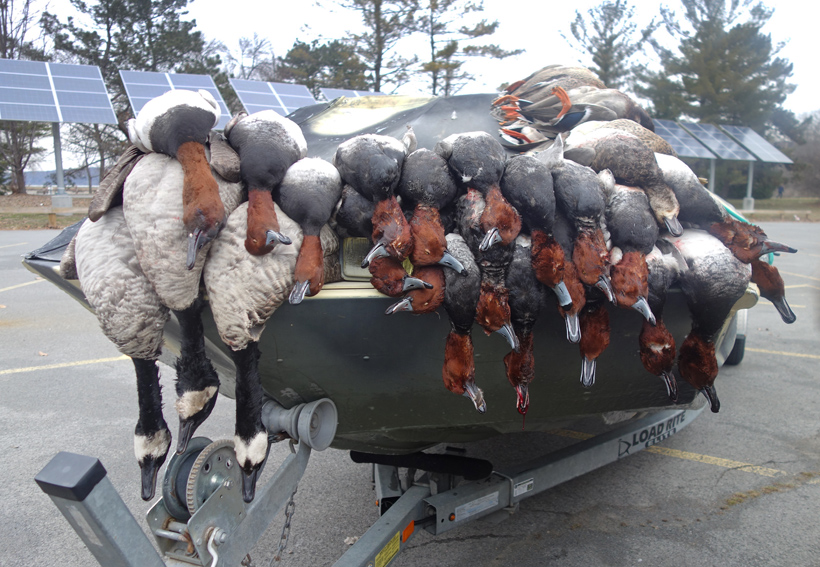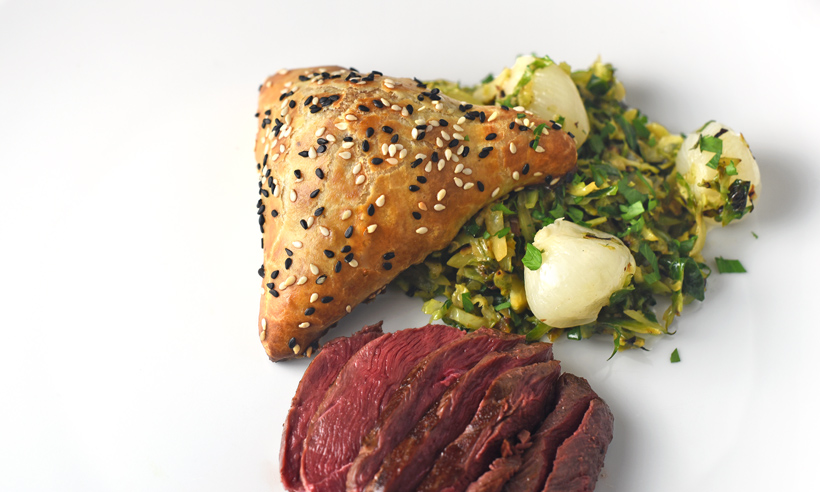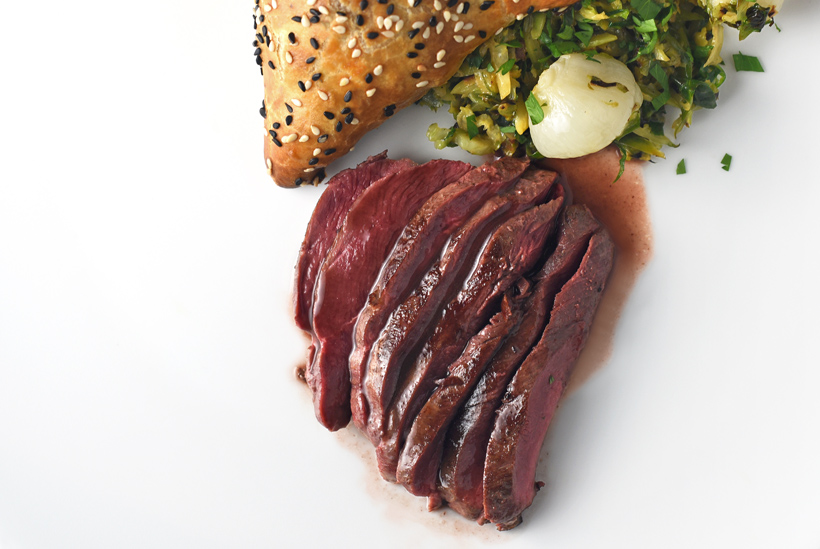Duck hunting season is just starting here in New York State, which is rather hard to imagine considering that we’re still running the air conditioners to fight off seemingly never-ending summer temperatures. Did the ducks really start migrating south when it’s just as warm now in October as it was in August? I’ll find out soon enough, but in the meantime, let me reheat some duck stories from last season…
At the beginning of the year, and for the first time, I decided to take advantage of Western New York’s short but productive January season. Captain Bill Saiff resettles in Ithaca for a couple of weeks, and each morning before dawn he breaks the ice with his funny little camouflage boat, in order to ambush huge teams of ducks and geese. Is the hunt so successful every year? I don’t know, but that trip was well worth braving the freezing temperatures — and the portable heaters helped, too. There are pros and cons to going to the Finger Lakes rather than Lake Ontario (where I’ve been many times in the past): the drive from NYC is shorter and there’s a lot more to do in the Finger Lakes region, but as a consequence it feels less remote, and you don’t have the dubious honor of staying at the West View Lodge. I’ll just have to try both areas again next time around.

To cook all the ducks I bring back from my trips (such as my share of the redheads pictured above), I’m on the lookout for duck recipes all year long, and I maintain a special page where I write down new ideas. Compared with their domestic cousins, wild ducks bring extra challenges: you mustn’t eat the skin, fat, or offal because of chemical contaminants; the breast (the magret) tastes so good it justifies a night or two at the West View Lodge, but can really only be seared and served rare or medium rare; outside of the breast, there isn’t a whole lot of meat to pick, and what meat there is can be pretty tough if not cooked for a long time. All these constraints reduce the realm of possible preparations.
This time, I’ve taken inspiration from a dish served at Marcel Ihnačák restaurant in Mikulov, that lovely Moravian town in Czech Republic. Namely, the “pastry filled with duck meat, with white cabbage and plum sauce,” from the Jewish menu — see my recent post here for the whole story. I’ve kept the idea of the duck pastry, which reminds me a lot of a Central Asian samsa, and the very Czech plum sauce. The stewed white cabbage has become sautéed Brussels sprouts, and this is a recipe that may finally reconcile you to these infamous cruciferous vegetables. Then I’ve added a seared duck magret, because, again, this is what wild ducks are all about.

Duck confit
Yields 4 servings
185 g wild duck scraps (boneless meat from legs and wings)
2.7 g salt
1 g sugar
0.4 g ground caraway seeds
20 g duck fat
- In a bowl, toss the duck scraps, salt, sugar, and ground caraway. Transfer to a sous-vide pouch, add the duck fat, and vacuum-seal. Cook in a 70 C / 158 F water bath for 16 hours.
- Take the pouch out of the water bath, and let cool for 30 minutes.
Duck pastries
Yields 4 servings (4 pastries)
duck confit
100 g peeled sweet onion, small dice
10 g butter
salt
black pepper, ground
15 g (about 1) egg yolk
20 g milk
about 200 g puff pastry
about 4 g black and white sesame seeds
- Take the duck confit out of the sous-vide pouch, and reserve the cooking liquid. Chop the meat into small dice and transfer to a bowl.
- In a small saucepan over medium heat, sauté the onion in the butter until soft. Season with salt and pepper, add the duck cooking liquid, and reduce completely.
- Remove from the heat, add to the duck meat, and rectify the seasoning. Let cool, and refrigerate for at least 1 hour.
- In a small bowl, mix the egg yolk and milk to make an egg wash.
- Divide the puff pastry into 4 pieces of 50 g each. On a lightly floured surface, roll each one into a disc of 12 cm diameter, trying to make the edges slightly thinner. Never flip the dough.
- Place some duck filling in a triangular shape at the center of each disc. The filling-to-meat ratio should be approximately 1.2:1 (I had 60 g of filling per pastry). Brush the edges of the dough with egg wash, then fold to shape each pastry into a triangle.
- Flip each pastry, brush with egg wash, and sprinkle with black and white sesame seeds. Transfer to a baking sheet lined with parchment paper.
- Bake in a 220 C / 425 F oven for 20-25 minutes, until golden brown. Reserve on a cooling rack.
Creamy pearl onions
Yields 4 servings
120 g peeled pearl onions
salt
40 g heavy cream
- Season the pearl onions with salt, then transfer to a sous-vide pouch, adding the cream. Vacuum-seal, then cook in 95 C / 200 F water bath for one and a half hours.
- Take the pouch out of the water bath, and reserve. You can prepare the onions up to a day in advance.
Sous-vide duck magrets
Yields 4 servings
4 wild duck magrets, about 80-90 g each
salt
canola oil
20 g butter
- Season the duck magrets with salt. Heat a pan with some canola oil over high heat, then quickly sear the breasts to brown on both sides.
- Transfer the magrest to a sous-vide pouch, add the butter, and vacuum-seal. Cook in a 49 C / 120 F water bath for one hour, and reserve.

Plum sauce
Yields 4 servings
20 g shallots, small dice
20 g butter
salt
black pepper, ground
60 g red wine
90 g beef stock
45 g damson plum preserves
- In a small saucepan over medium heat, sauté the shallots in half of the butter until translucent. Season with salt and pepper, add the wine, and reduce by half.
- Add the beef stock, and reduce by half again.
- Transfer the sauce to a blender, and add the damson plum preserves and the remaining butter. Blend until smooth, then pass through a chinois, and reserve.
Sautéed Brussels sprouts
Yields 4 servings
290 g Brussels sprouts, thinly sliced
20 g light olive oil
salt
black pepper, ground
50 g milk
creamy pearl onions
3 g parsley, finely chopped
1 g lemon zest, grated with a Microplane grater
- In a pan over high heat, sauté the Brussels sprouts in the olive oil until they just start to brown.
- Season with salt and pepper, then add the milk plus the onions and cream from the sous-vide pouch. Reduce the heat to medium, and cook until the Brussels sprouts are tender.
- Remove from the heat, and stir in the parsley and lemon zest. Reserve.

Assembly
Yields 4 servings
duck pastries
plum sauce
sous-vide duck magrets
salt
black pepper, ground
sautéed Brussels sprouts
- Reheat the duck pastries in a 175 C / 350 F oven for a couple minutes if needed.
- Reheat the plum sauce in a saucepan over low heat (or in the microwave) if needed.
- Take the duck magrets out of the sous-vide pouch. Optionally, sear them again very quickly on both sides in a hot pan. Slice each breast lengthwise, then season with salt and pepper.
- On each plate, spoon a small mound of sautéed Brussels sprouts, and rest a duck pastry against it. Then place a sliced duck magret, and coat with plum sauce. Serve.

